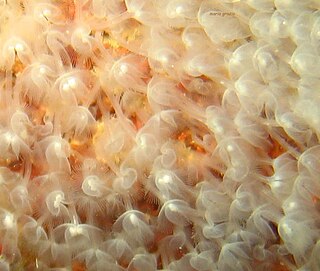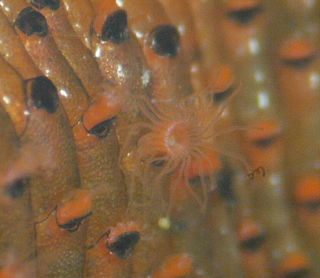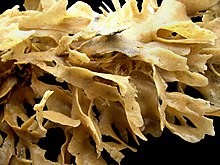
Cheilostomatida, also called Cheilostomata, is an order of Bryozoa in the class Gymnolaemata.

Membraniporidae is a bryozoan family in the order Cheilostomatida. Membranipora form encrusting or erect colonies; they are unilaminar or bilaminar and weakly to well-calcified. Zooids have vertical and basal calcified walls, but virtually no frontal calcified wall: most of the frontal surface is occupied by frontal membrane. An intertentacular organ is also present. The larvae are not brooded. The ancestrula is generally twinned. Kenozooids may be present in a few species; modified zooids analogous to avicularia are rare.

Membranipora is a genus of bryozoans in the family Membraniporidae. A typical example is the widely distributed species Membranipora membranacea that commonly encrusts seaweeds, particularly fronds of the kelps Laminaria digitata, L. hyperborea, and Saccorhiza polyschides.

The Catenicellidae are a family of bryozoans in the suborder Flustrina.

Brachiozoa is a grouping of lophophorate animals including Brachiopoda and Phoronida. It also includes their ancestors, the extinct tommotiids.

The Ctenostomatida are an order of bryozoans in the class Gymnolaemata. The great majority of ctenostome species are marine, although Paludicella inhabits freshwater. They are distinguished from their close relatives, the cheilostomes, by their lack of a calcified exoskeleton. Instead, the exoskeleton is chitinous, gelatinous, or composed only of a soft membrane, and always lacks an operculum. Colonies of ctenostomes are often composed of elongated, branch-like stolons, although more compact forms also exist.

Watersipora is a genus of bryozoans belonging to the family Watersiporidae.

Catenicella is a genus of marine bryozoans belonging to the family Catenicellidae. Bryozoans are colonial animals that live in aquatic environments, and Catenicella is no exception. Members of this genus are found in oceans around the world, with a particularly high diversity in the Arctic and Antarctic regions.
Catenicella elegans is a species of bryozoans in the genus Catenicella. It is found in New Zealand.
Carbasea elegans is a species of bryozoans in the family Flustridae found in Australia.
Crisia is a genus of bryozoans in the family Crisiidae. Some species are known from the fossil record.
Licornia is a genus of gymnolaematan bryozoans.

Beania magellanica is a species of colonial bryozoan in the family Beaniidae. It has a cosmopolitan distribution, occurring in shallow waters in the Atlantic and Pacific Oceans and in Antarctica.
Beania is a genus of bryozoans belonging to the family Beaniidae.
Alysidiidae is a family of bryozoans belonging to the order Cheilostomatida.
Farciminariidae is a family of bryozoans belonging to the order Cheilostomatida.
Quadricellariidae is a family of bryozoans belonging to the order Cheilostomatida.

Aetea is a genus of bryozoans belonging to the family Aeteidae.
Farciminaria is a genus of bryozoans belonging to the family Farciminariidae.
Menipea is a genus of bryozoans belonging to the family Candidae.








